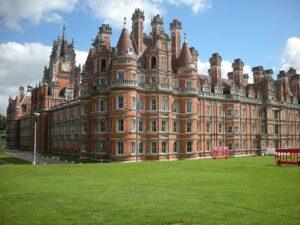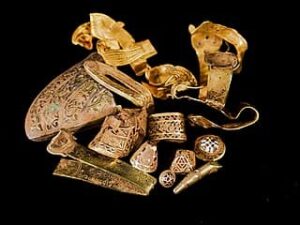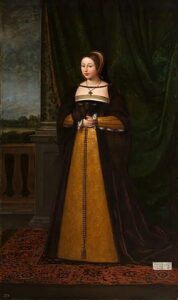•
(Caution: Contains spoilers for Episodes: S05E04: Mord am St Malley’s Day, S14E05: The Sleeper under the Hill, S18E05: Saints and Sinners, and a little bit S09E04: Down Among Dead Men)
Diesen Beitrag gibt es auch auf Deutsch.
•
Three episodes of Midsomer Murders are about treasure and its theft. They come from three different eras: The Anglo-Saxon treasure of Gorse Meadow from the Battle of Hallows Beck between the Anglo-Saxons and the Vikings (14×05: The Sleeper under the Hill) and the Tudor hoard of Milson (18×05: Saints and Sinners) – both treasure heists taking place in Midsomer in the early 21st century.
But one episode also features an art theft outside Midsomer, but in Midsomer Parva. Specifically, by former Pudding Club members, now diplomats, in the last decades of the 20th century (05×04: Murder on St Malley’s Day).
There is another treasure hunt in “Down Among Dead Men” involving the Florins. They regularly dive for the sunken treasure that was on board the “Harlequin”, which ran aground on Fuller’s Sweep not far from Fennacombe Bay. It was carrying gold artefacts from France. Unlike other treasure hunters, however, the Florins simply want to sell the treasure and make money – they do not see themselves as the guardians of the treasure, the only ones who can judge its value.
Greed & Hubris

What all episodes have in common is that the robbers claim to be able to value the treasures for themselves – and only themselves – and therefore need to save them – and, of course, are prepared to murder if necessary to do so.
At Devington School in Midsomer Parva, headmaster Jonathan Eckersley-Hyde stands with pupil Daniel Talbot in the chamber of the Pudding Club, where many treasures are kept. He seems to be preparing Daniel for his future career as a diplomat. And as an alumnus of Devington School, that includes, er, saving artefacts. He shows Daniel something from a looted museum in Kabul, the contents of which were stolen/saved and brought here by members of the Pudding Club as diplomats. This is what makes the school and its upkeep possible.
(More Midsomer Parva history? —> This way, please.)
Daniel Talbot is understandably beside himself that there are countless stolen art treasures stored here, and Jonathan Eckersley-Hyde emphasises once again that these treasures have been saved thanks to Devington School.
And it’s not just Kabul artefacts that are stored in the secret vault off to the side of the Pudding Club room. Tom Barnaby and Gavin Troy identify much more in the room when Jonathan Eckersley-Hyde also enters the vault.
Anglo-Saxon treasures
There is a prehistoric monument with a blood stone at Midsomer Mow. This area is part of the Gorse Meadow estate, now owned by Alex Preston. Unauthorised, the village’s New Dawn Druids use the site as a spiritual power site to celebrate their beliefs.
But landowner Preston has his own plans for the land and wants to make it work for him. While ploughing, he makes a very interesting discovery after only a few metres: he finds ancient jewellery under the ground and quickly realises that there must be much more from Celtic times. He shows his first finds to another resident, Caradoc Singer. He is very impressed, but not so much by the fact that Alex Preston wants to find out how to deal legally with a treasure find.
Caradoc Singer believes that only he has the ability to value the hoard, not Alex Preston or the government. Or the policeman Trevor Gibson, who also wants Preston’s find and wants to sell it. Caradoc Singer – who considers himself far too good to kill – takes advantage of this and has Trevor Gibson do it for him, putting him under emotional pressure.
All this is revealed during the interrogation in Caradoc Singer’s basement lair at the end of the episode, as Caradoc Singer, surrounded by all the treasures he has collected over the years, sits in an armchair and remembers the day Alex Preston showed him the precious finds.
Arrogance

The catastrophe for Caradoc Singers was not that Alex Preston found these treasures on his property, but that he want to report his find and take whatever might be his legal share. And once the items were in the possession of the government, Caradoc Singer could no longer try to own them. Clearly, finds Singer, Alex Preston was not appreciative enough and therefore had to die.
But an art collector like Caradoc Singers doesn’t do this kind of dirty work himself, but lets others do it, whom he makes emotionally compliant in return with small gifts – in this case the policeman Trevor Gibson. Nothing he regrets, as you can see from his arrogant grin. He is visibly proud of his emotional blackmail.
Same with Letitia Clifford, a member of the New Dawn Driuds of Midsomer Mow . She finds the right site of the buried treasures via ley lines. On a large map she connects four spiritual places with two lines. They cross at Gorse Meadow. “King Stone” she writes at the intersection. Shortly afterwards she is murdered.
Pure Arrogance
John Barnaby showed the map to Caradoc Singer, who back then waved it off, to distract Barnaby. He admits this later. She was quite right that the battle was fought at Gorse Meadow. But if this had been publicised, the place would have been swarming with treasure hunters – and thus diminishing Caradic Singer’s potential possessions.
There were at least four battles between Anglo-Saxons and Vikings in Berkshire, Buckinghamshire, and Oxfordshire, but only one of it was won by the Anglo-Saxons: The Battle of Englefield, 31 December 870. (According to the calendar at that time, it was 31 December 871 because the year already began on Christmas.)
But how did it actually come to the battles? About a century after the Christianisation of the Anglo-Saxons, the Vikings sailed to the British Isles for short raids.It was not until around 850 that Vikings invade Britain – and it was during this time that the Battle of Englefield took place.
Ley Lines
Let’s come back to Letitia Clifford for a moment. She draws two lines – called ley lines – on a map. They meet in Alex Preston’s field, though not at the bloodstone in Crowcall Circle, but a few steps away. “King Stone” she writes on the spot.
Drawing ley lines is not an idea of the screenwriter, but is based on a practice of 19th century historians. Today, their significance is strongly doubted by historians and tends to be relegated to the realm of esotericism. They were established by merchant Alfred Watkins who was also an amateur archaeologist and amateur photographer. For him, there had to be a network of straight paths connecting the historic buildings in England.
And he wasn’t alone:
- Reverend Edward Duke (1779-1852) found in 1846 that some prehistoric monuments and medieval churches were connected by a line.
- Architect and antiquarian Joseph Houghton Spencer (19th century), while exploring Taunton Castle, found a historic path connecting monastic sites. He then believed that all monasteries and monuments would once have been connected in straight lines.
- Archaeoastronomer Joseph Norman Lockyer (1836-1920) suggested that, as at Stonehenge, other prehistoric stone sites were connected on a plane based on astronomical principles.
- Historian Walter Johnson (c. 1900) found that because churches were built on prehistoric sites, ley lines are also found in them, but go back even further. Churches were built because of the positive energies along the ley lines.
Nevertheless, the vast majority of scientists today are very sceptical about the anachronistic concept of ley lines. Tom Williamson found that the density of monuments in the UK is so great that with every straight line you have several monuments on one line.
Treasures from family hoards

Cicely Milson was a martyr who was interrogated by her torturers for three weeks before she was executed. Among other things, she lost a toe during the torture. Her family fled to France to escape, but the family hoard, however, remained with Cicely. She probably lived in the 15th century – more likely towards the end. Historian Christopher Corby gives the 15th century for the painting showing her mother Benedicta Milson (in fact it shows Margaret Tudor (1489-1541), the eldest daughter of Henry VII of England).
The dig in present-day Midsomer Cicely is also attended by Penelope “Penny” Henderson, who wrote her PhD thesis on the Milson family and knows a lot about the connections and the family hoard. It is only towards the end of the episode that John Barnaby and Charlie Nelson find out from the car registration that Penny Henderson’s maiden name was “Milson”. So, she is interested in finding the treasures of the Milson family for genealogical reasons and wants to keep it. But that’s not how it works under current law in England. In the process, Penny Henderson is willing to go to extremes and becomes a murder.
Note: As with Gorse Meadow: where the scene of the dig was set up is still unknown to me and I welcome any clues.
Fraud and Murder
And then there was the Reverend Corby, who passes off the bones of a random person as the relics of St Cicely in order to gain more fame.
He steals Penny Henderson’s car with the actually bones of Cicely in it to replace them in the crypt for the bones of the fake Cicely. What he doesn‘t know is that the family hoard is in the car, too. Kam Karimore drops by in the church to examine the fake bones on display for their age. While she is still discussing the matter with the Reverend, Penny Henderson arrives. They get into arguments when John Barnaby and Charlie Nelson also arrive to join the three people in the crypt.
For a moment, Penny Henderson is surprised, that the police have discovered that she is the murderer. Then pulls out a knife and runs to Kam Karimore to take her hostage. Kam gasps. John is visibly in distress. He reveals to her that he knows of her birth name, lets her get emotional until she is not paying close attention to holding Kam Karimore down enough. Kam is able to break free. John and Charlie immediately rush towards Penny Henderson. Kam and Charlie hold Penny Henderson down, so she can be arrested.
How does it work in England when you find treasures?
This is regulated by the Treasure Act of 1996: There is a legal obligation that golden and silver objects over 300 years old found in England must be reported within 14 days of discovery. A finder’s reward is possible, but does not apply to archeologists and volunteers participating in an archeological excavation.
Read more about Midsomer Murders & History
The Chronology of Midsomer County by Year or by Episodes
Deep Dives into Midsomer & History
This is an independent, non-commercial project. I am not connected to Bentley Productions, ITV or the actors.

Literature
- Ford, David Nash: Englefield. In: Royal Berkshire History. URL: http://www.berkshirehistory.com/villages/englefield.html
- Hutton, Ronald: The Pagan Religions of the Ancient British Isles. Their Nature and Legacy. Oxford/Cambridge 1991.
- Johnson, Walter: Byways in British Archaeology. Cambridge University Press 1912.
- Lockyer, Joseph Norman: Stonehenge and Other British Stone Monuments Astronomically Considered. Macmillan and Company, London 1909.
- NN: Parishes: Englefield. In: P. H. Ditchfield/William Page (Eds.): A History of the County of Berkshire 3. London 1923. P. 405-412. URL: https://www.british-history.ac.uk/vch/berks/vol3/pp405-412
- Williamson, Tom/Bellamy, Liz: Ley Lines in Question. Tadworth 1983.
First published on MidsomerMurdersHistory.org on 27 January 2024.
Updated on 17 July 2025.


7 thoughts on “Treasures & Raiders in Midsomer County”